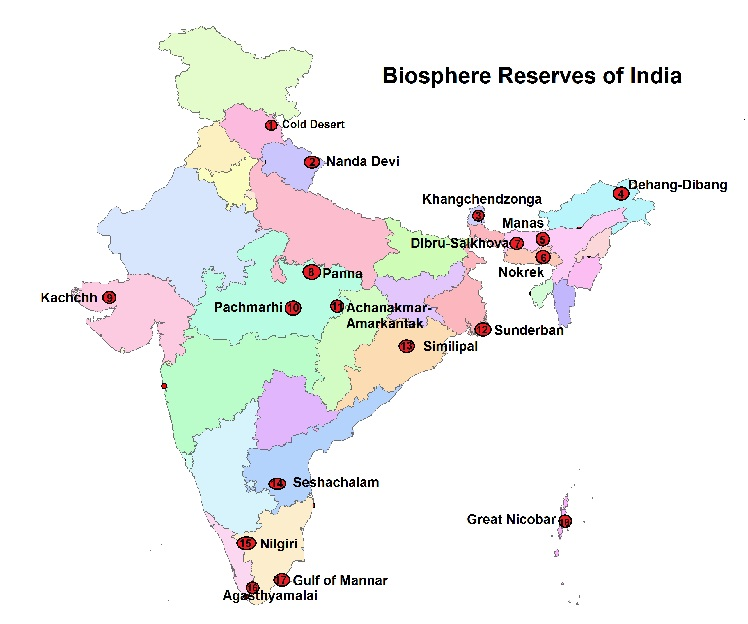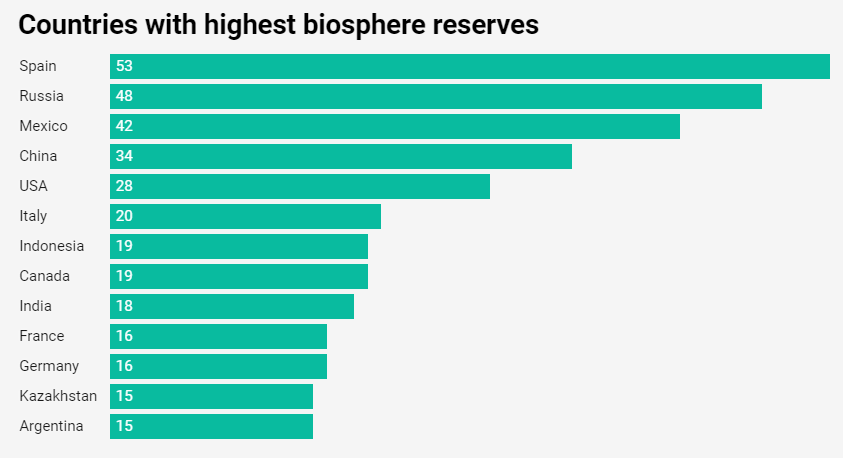International Day for Biosphere Reserves | 04 Nov 2022
For Prelims: Biosphere Reserve, United Nations Educational, Scientific and Cultural Organization (UNESCO), Biosphere Reserves in India, Man and Biosphere Programme.
For Mains: Biosphere Reserves: Criteria for Designation, Main Zones, Functions, International Status.
Why in News?
From 2022 onwards, 3rd November will be celebrated as 'The International Day for Biosphere Reserves'.
What are Biosphere Reserves (BR)?
- About:
- BR is an international designation by (UNESCO) for representative parts of natural and cultural landscapes extending over large areas of terrestrial or coastal/marine ecosystems or a combination of both.
- BR tries to balance economic and social development and maintenance of associated cultural values along with the preservation of nature.
- BRs are nominated by national governments and remain under the sovereign jurisdiction of the states where they are located.
- These are designated under the intergovernmental Man and the Biosphere (MAB) Programme by the Director-General of UNESCO following the decisions of the MAB International Coordinating Council (MAB ICC).
- The MAB Programme is an intergovernmental scientific programme that aims to establish a scientific basis for enhancing the relationship between people and their environments.
- Their status is internationally recognized.
- Three Main Zones:
- Core Areas: It comprises a strictly protected zone that contributes to the conservation of landscapes, ecosystems, species and genetic variation.
- Buffer Zones: It surrounds or adjoins the core area(s), and is used for activities compatible with sound ecological practices that can reinforce scientific research, monitoring, training and education.
- Transition Area: The transition area is where communities foster socio-culturally and ecologically sustainable economic and human activities.
What is the Status of Biosphere Reserves in India/World?
- In India:
- India at present has 18 notified biosphere reserves spanning 60,000 sq km.
- The first biosphere reserve in India was the blue mountains of the Nilgiris stretching over Tamil Nadu, Karnataka and Kerala.
- The largest biosphere reserve is the Gulf of Kachchh (Gujarat) and the smallest is Dibru-Saikhowa (Assam).
- Other bigger biosphere reserves are the Gulf of Mannar (Tamil Nadu), Sunderbans (West Bengal), and Cold Desert (Himachal Pradesh).
- Around the World:
- About:
- There are 738 biosphere reserves in 134 countries, including 22 transboundary sites, according to UNESCO.
- Region-Wise:
- The highest number of reserves are in Europe and North America followed by Asia and the Pacific, Latin America and the Caribbean, Africa and Arab states.
- In South Asia, over 30 biosphere reserves have been established. The first one was the Hurulu Biosphere Reserve, in Sri Lanka, with 25,500 hectares of tropical dry evergreen forest.
- Bangladesh, Bhutan, and Nepal do not have biospheres as yet.
- Country-Wise:
- The highest number of such sites are in Spain, Russia and Mexico.
- World’s First 5-country Biosphere Reserve:
- Stretching across Austria, Slovenia, Croatia, Hungary and Serbia, the world’s first 5-country biosphere reserve, which has been declared by UNESCO in September 2021 covers 700 km of the Mura, Drava and Danube rivers.
- It is Europe's largest riverine protected area, covering almost 1 million hectares, and known as the 'Amazon of Europe'.
- About:
Way Forward
- Land rights of tribals which depend on the forest resources in transition areas must be secured.
- Munnar declaration which suggests that biosphere reserves can be carved out of the desert and Gangetic plain bio-geographic zones should also be implemented.
- As the biosphere reserve concept was aimed at sustainable development, the term, reserve, should be replaced with a suitable word.
- The government must take strict steps against alien species invading various biosphere reserves e.g., Nilgiri Biosphere Reserve.
UPSC Civil Services Examination, Previous Year Question
Q. Consider the following pairs: (2013)
- Nokrek Biosphere Reserve : Garo Hills
- Logtak (Loktak) Lake : Barail Range
- Namdapha National Park : Dafla Hills
Which of the above pairs is/are correctly matched?
(a) 1 only
(b) 2 and 3 only
(c) 1, 2 and 3
(d) None
Ans: (a)
Q. The most important strategy for the conservation of biodiversity together with traditional human life is the establishment of (2014)
(a) biosphere reserves
(b) botanical gardens
(c) national parks
(d) wildlife sanctuaries
Ans: (a)
Q. Out of all the Biosphere Reserves in India, four have been recognized on the World Network by UNESCO. Which one of the following is not one of them? (2008)
(a) Gulf of Mannar
(b) Kanchenjunga
(c) Nanda Devi
(d) Sunderbans
Ans: (b)
Source: TH


